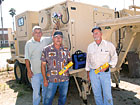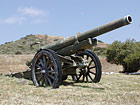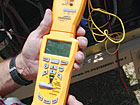
To guard against combat operations and communications failures, HVAC technicians count on their tools while keeping military computers cool in the field.
They’re a critical part of the work HVACR technicians do. Often called “tools of the trade,” the instruments and tools a technician has in his bag are almost as important to him as his expertise. A tech can possess all the knowledge and experience in the world, but if one of his tools fails or is inaccurate, it can really ruin his day and do damage to his employer’s business. In the case of Warren Brader and his crew, lives could literally hang in the balance.
Brader is the leader of a team of HVACR technicians from a major defense contractor who maintain and repair HVAC systems and power generators for a branch of the military at their bases round the world.
“It’s about much more than keeping the soldiers comfortable,” said Brader. “The most important charge we have is to maintain the HVAC equipment that serves the computer operations. Those computers are critical to the military at every level, and they can’t afford to have them go down because an air conditioning unit malfunctioned.”
Most people think of military computers as those used at military bases for routine tasks such as data processing, but the ones most critical to the military are those used in armed conflicts including those in Iraq and Afghanistan.
DANGER TO BATTLEFIELD COMPUTERS
“All the computer information is classified,” said Brader. “But I can tell you that those central operations are essentially the offices in the field. The commanders spend much of their time there and, if an a/c unit goes down, the temperature ramps up in the servers in that facility and they go down, too.“If that happens, they lose computer capability for everything. All communications goes down, artillery, fire command, combat operations centers, everything. The systems immediately go to backup power, and we do not lose data, but the standby power is for an emergency, and not doing your job correctly is not an emergency. It is mandatory to get it right the first time using the proper tools and test procedures. So you can see why it is critical to keep those a/c units up and running at maximum efficiency, especially in the summer.”

The U.S. military utilizes computers in various
aspects of its operations, which need cooling, whether on base or in the field.
RECRUITING QUESTIONS
When recruiting new technicians, he starts every interview with a prospective employee by asking a technician what tools he uses in the field.“First, I ask them if they use digital equipment,” he said. “You’d be surprised how many are afraid of digital technology and cling to their analog instruments. Then I have a series of questions on diagnostic techniques that are designed to reveal if they take shortcuts. But, even if they pass the interview, there’s still a good chance that they will lack the meticulous commitment to our procedures that this job demands. That’s where instrumentation comes in.”

Robert Cerio (left), technical service
specialist, Warren Brader, senior project engineer, and William Bricknell,
technical service specialist, keep military HVAC units
running.
STANDARDIZED INSTRUMENTATION
The first thing Brader did when he arrived at his present job was to, as he likes to say, “get everybody on the same sheet of music.” He did that by making sure all his technicians used the same instruments - what he calls “The Right Stuff.”As a perfectionist with 25 years of experience in HVAC, he has deep-set hatred for callbacks. He says the way to prevent them is by consistency of testing methods and the elimination of shortcuts.
“I have a group of technicians at bases around the globe reporting to me either directly or indirectly,” said Brader.
“The challenge, and it’s a big one, is to make sure everyone is on the same sheet of music, using the same procedures, and having a way to check on them to make sure they aren’t taking shortcuts. It’s an enormous challenge with devastating results if they don’t all perform their maintenance in the same way every time and with the same degree of accuracy. And in the case of the Middle East conflicts, the consequences could be even more devastating.
“When I came here, I made sure that everyone working under me used the same instrumentation. I was using a fieldpack, which consisted of a digital stick meter, a data logger, an electronic handle, and 11 modular test heads that fit all three and measure just about everything an HVAC tech needs to measure. They give me the accuracy I need and are extremely portable. I saw to it that everyone working under me had one. And that was good as far as it went. But it still didn’t give me control over the guys in the field. I still couldn’t guarantee that they were doing everything by the book.”

According to Warren Brader, “Central operations
are essentially the offices in the field. If an a/c unit goes down, the
temperature ramps up in the servers in that facility and they go down, too. …
All communications goes down - artillery, fire command, combat operations
centers, everything.”
ASSEMBLING THE RIGHT STUFF
In response to his continued aversion to callbacks, especially those half a world away, Brader was commissioned by his military client to put the perfect standardized tool kit together for all the technicians.“When a chance to upgrade comes along, you don’t pass it up,” he said. “I would need a multimeter, a clamp meter, different ways of carbon monoxide testing, something to analyze superheat with, and different manifold sets. While deciding what tools and instruments would fulfill those needs, I thought ‘There’s got to be some new technology that will make my technicians’ jobs easier and make them more versatile while giving me more control.’ I did extensive research on all the instrument makers and their latest offerings, and when I was done, I was back at the same instrument company I started with - Fieldpiece. They had just introduced their new system analyzer and it looked great on paper. I ordered one online to evaluate it.
“Their HVAC Guide® System Analyzer is a hand-held instrument that basically takes the tech by the hand and leads him through each step,” he said. “More important, it records a test and its results so that we have a record of what was done. For instance, a technician needs to measure superheat. He enters the type of refrigerant into the analyzer. It instructs him to take wet bulb and dry bulb temperatures and suction line temperature and pressure. The technician uses the modular accessory test heads he already has in his fieldpack and attach them to the analyzer to enter results directly into the meter. When all measurements have been taken, the instrument gives the technician the target and the actual superheat.”

“At a mobile command center, Brader checks the
refrigerant charge and temperature drop across the evaporator coil using the
Target Evaporator Exit Temperature and Superheat tests built into the HVAC
Guide® System Analyzer.”
MONITORING TECHS IN THE FIELD
“When I speak to my technicians in the field over the phone or via e-mail, they send me the test results directly to my computer. More important, I can store the data on the share drive for every tech around the world to see what is being done to other units and use this data to track repeat problem areas and evaluate the quality of work. Then I can send that data upon request to our customer to back up our work requests and show the quality of the job.”It gives Brader what he had been seeking: meticulous control over the maintenance procedures and measurements in the field which translates into reduced callbacks. “Let me give you an example,” Brader said. “We had to do a major changeout of some control valves and a compressor. After finishing the changeout we were faced with what used to be a lengthy process to adjust those valves so the superheat on the evaporator is just right. These things have to be spot-on or the system won’t work right. The superheat called for 10° and, using the analyzer to make the adjustments, our test results were 10.5°. We were only 0.5° off - essentially a gnat’s eyelash. In the past it would have taken us a lot longer to get anywhere near that accuracy.”
CONTROL OF HEATING SYSTEMS
But it’s not just a/c systems that he is able to monitor, there’s heating systems as well.“Recently the manufacturer of the analyzer we use came out with a firmware upgrade for the analyzer that includes the CheckMe!® program. We were given an ad- vance copy and uploaded it to four of our analyzers. We can use it to certify both heating and a/c systems to assure they’re up to ASHRAE [American Society of Heating Refrigerating and Air-Conditioning Engineers] specs. In heating, it works with both electric and gas units. It will tell you likely causes of problems. Test results can be saved so you have records of everything. We check combustion analysis, CO, test the pilot, and air quality. With an a/c unit we can enter different parameters. We put in all factory specs, and the instrument will tell you if the system is operating optimally. We simply don’t have callbacks because we don’t miss parameters and we know when something is weak.
“It used to be that I constantly worried that my technicians might have developed bad habits and be doing things the way they used to instead of how I wanted them to. I speak to a lot of technicians over the phone regularly to help talk them through things, and with the analyzer and other test instruments, I can easily talk them through it step by step using standardized equipment. The instruments make them build good habits and, when they stick to those habits, they’re 100 percent accurate, and we’re all on the same sheet of music.”
“Now other contractors who maintain the same type of equipment for other branches of the military around the globe are using us as a model and seeing the benefits of a standardized set of tools.”
THE IMPORTANCE OF THE RIGHT STUFF
Over his 25-plus year career, Brader’s Right Stuff list has changed as technology improved. Because of space considerations, we can’t list all of them here, but, in addition to Fieldpiece, the list includes tools and instruments from such industry standards as WestAir, Airgas, Ababa Bolt, Appion, Yellow Jacket, Imperial Eastman, Ritchie, Mastercool, and Sears.“Special care was given to the selection for quality as well as cost-effective, efficient tools to be used in doing high-quality repairs and modifications to equipment,” says Brader. “Of course, other contractors have their own choices of tools and instruments that they have had success with. The important thing is to make sure that everything is standardized so all of the technicians are on the same sheet of music, that they all stringently follow the same procedures, and that the contractor has the means to monitor and record their procedures.
“When used properly, the tools and procedures will allow the technician to be very accurate when troubleshooting, repairing, and performing preventive maintenance duties on assigned equipment. And by monitoring each technician’s work, the contractor can be assured no shortcuts are being used and that callbacks are kept to an absolute minimum.”
Publication date:06/28/2010


Report Abusive Comment